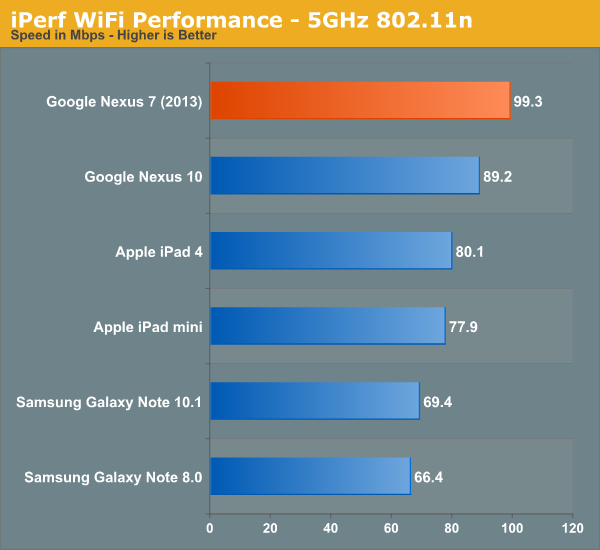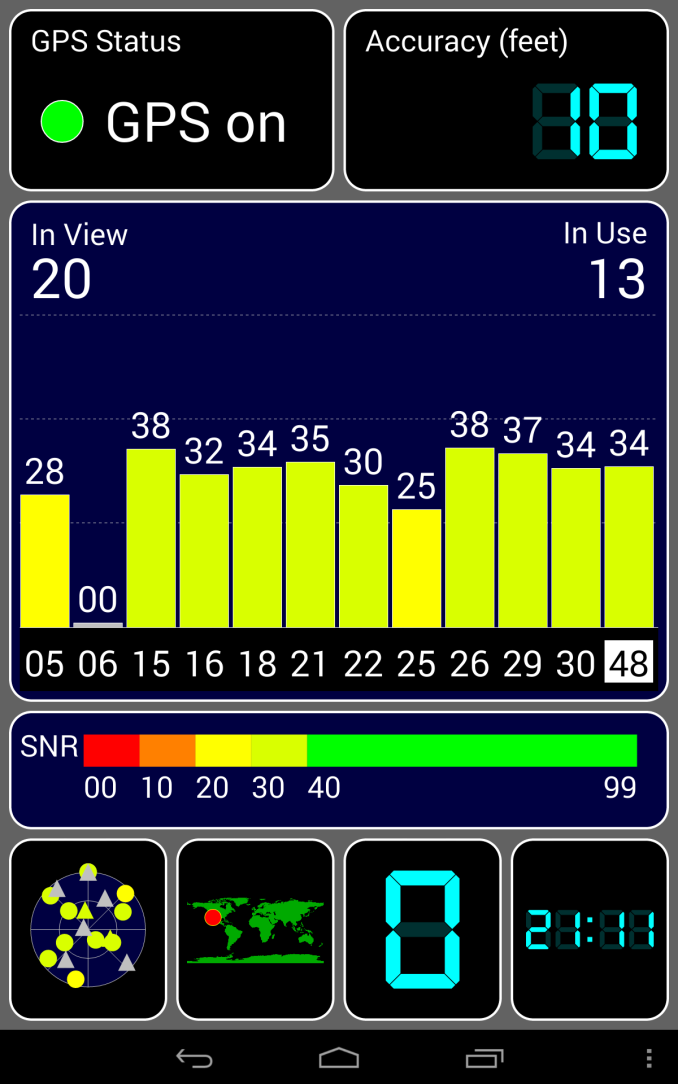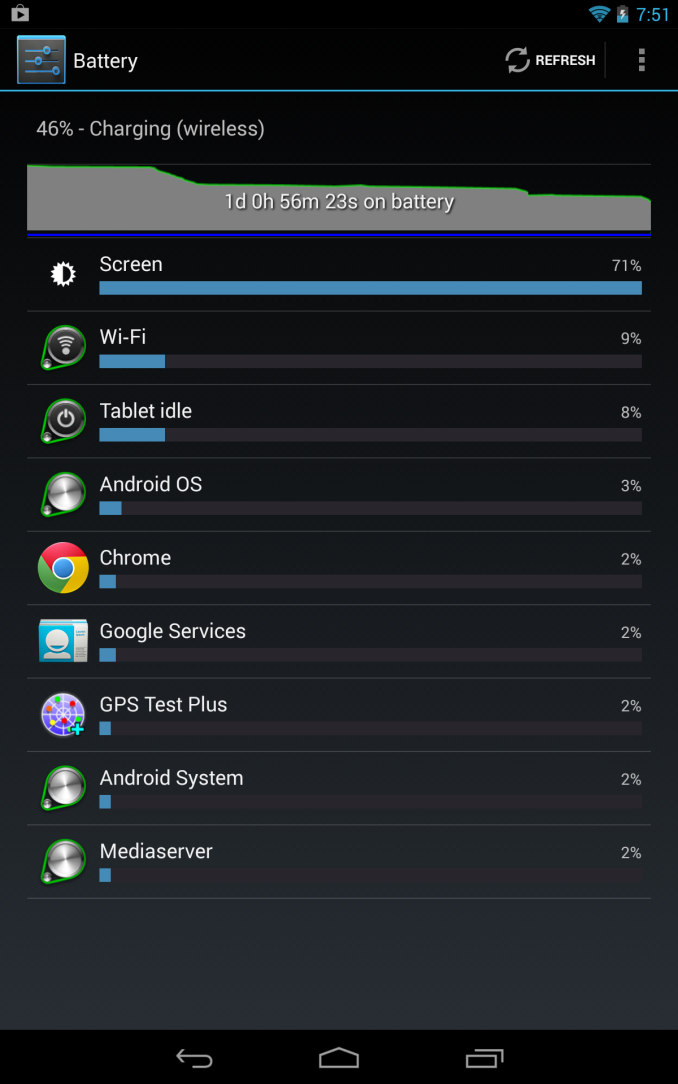Nexus 7 (2013) - Mini Review
by Brian Klug on July 27, 2013 12:54 AM EST- Posted in
- Tablets
- Snapdragon
- Qualcomm
- Android
- Mobile
- APQ8064
- Nexus 7
- Android 4.3
One of the biggest complaints I had about the original Nexus 7 was connectivity, as it only included 2.4 GHz 802.11b/g/n support. The hilarity of that situation was only compounded by the fact that Google could only demo the Nexus 7 at that Google I/O plugged in through USB-OTG Ethernet adapters because 2.4 GHz is effectively impossible to use at conferences. With the new Nexus 7, dual band (2.4 and 5 GHz) WLAN is now included with a WCN3660, Qualcomm’s companion WiFi 802.11a/b/g/n, BT 4.0, and FM Tx/Rx combo (though FM features aren’t enabled on the Nexus 7 2013).

Performance is correspondingly improved, and if you’re in an urban area where 2.4 GHz is congested beyond use, this makes the difference between an unusable brick and working tablet. Many have asked, why not WCN3680 (the 802.11ac enabled successor to 3660), the answer is of course, you’re talking about a ~$200 tablet, stuff like this understandably has to be n–1 without making the bill of materials untenable.
There’s also GNSS (GPS+GLONASS) on the WiFi only model which I tested, this goes through WCN3660 and into the baseband on APQ8064 in this configuration I believe. I’ve had nothing but great success with Qualcomm’s GNSS being the fastest out there to 3D cold fix, that holds true with the Nexus 7 (2013), even walking around the urban canyon scenario that San Francisco poses to GNSS.
Charging
The Nexus 7 (2013) is Qi (pronounced: “chee”) enabled, the de-facto wireless charging standard of the now. The Qi charger area is dead center in the middle, using a coil inside of the NFC one. That makes positioning easy.
I tossed the Nexus 7 on my Energizer Qi two-position mat when I got home, and it works perfectly, of course Qi can only charge at up to 5 watts. The in-box supplied charger is a 1.35 A variant, which isn’t anything special. Connected to my special linear power supply and battery charge downstream port controller which negotiates the proper standard, I saw the Nexus 7 (2013) draw a max of 1.32 A (6.6 watts), which makes sense given the supplied charger. I don’t have a 0–100 percent charge time number yet.












252 Comments
View All Comments
lordlad - Monday, July 29, 2013 - link
you are definitely entitled to your opinion (being freedom of speech and all) and i will be the first to agree with you if it's android v1 till v3.0. But since 4.0 ICS and above, many of the UI quirks had been ironed out at a rapid pace and android is still the most featured (functional wise) mobile OS out there.Which mobile OS currently allows you to access your home NAS and copy/paste file from/to your mobile device? Such a no-brainer use-case but IOS can't do it. Windows Phone 8 can't do it. I have no idea about BB10 so i can't comment but Android can do this among others. Most of the Mobile platform out there to me are more like appliances OS platform whereby the function of the OS and devices are defined by the makers and app-creators. It's like a vacuum cleaner can only do vacuum cleaning. An appliances.
Android, at least from my perspective, it's a mobile computing platform. The OS performed a certain functions but there's no pre-defined role of what it can do or can't. You can probably put android in a nuclear missile launching silo and it will probably worked (with some re-tooling of course).
All I'm saying is android is more akin to having a full computer in a phone/tablet form factor.....while else the other platforms (IOS, Windows Phone) are more like phone and tablet appliance. I'm sure their user experience, being much more curated, resulted in a 'tighter' experience...but it also resulted in a much more 'restricted' experience..
I must have pulled out a few hairs when i am trying to attach certain files to an email i am typing on my ipad. Such is the result of a constrained, 'appliance' experience..
but alas, to each his own. ;-)
akdj - Saturday, August 3, 2013 - link
Interesting take. Especially Android tablets in launching silos. Word is most of those were built in the 60s 70s and 80s...the power in any of today's tablets far surpasses what computing power was available when those missiles were deployed. So you're right...they very well COULD work as a missile launch and targeting system....that said, they'd get the app AFTER iOS does;). Already over a half million iPads have been deployed by major airlines across the world. Including updated Jep charts and plates, real time weather and traffic conditions, etc. They decided to go with iOS. Not Android. While I'm brand agnostic (I've got iOS and Android devices) and prefer not to trumpet my opinions on a board read and provided by folks many times smarter than me...your take on Android is a bit 'over the top' at this time. iOS is a simple to use device that many 'power' users won't find able to fulfill their needs...but many moms n dads and grandmas and gramps...kids as well....checking email and Facebook, posting n manipulation of stills and video, watching Netflix or Hulu...messaging and browsing, the things they ONLY used their old desktop or laptop for, it's an absolute answer to their needs. Android is a bit more tricky to learn, a bit different to set up and use, and its lack of optimized tablet apps is a killer.While the case can be made that Android COULD in fact be a better all around computing device, I guess we'll just have to wait for the developers to take notice and advantage of such an excellent subsystem.
We'll see. Until then....you're definitely entitled to your opinion, as you say...according to the constitution (though not all readers of Anand are from the USA)...however, you're wrong. Sorry
J
kascollet - Sunday, August 4, 2013 - link
I connect my iDevices to my NAS on a daily basis. Works perfectly over SMB and AFP. The app is FileBrowser but there are others to perform this use case. With my former Nexus 4, I couldn't do it as flawlessly, whatever the app I tried.Smartphoneuser - Wednesday, July 31, 2013 - link
This is flame bait. You are in the minority. I always ignore trolls, but could not resist the temptationfor2015nexus7 - Sunday, July 28, 2013 - link
this got to be the best tablet review site. anyways, how is the.speaker comparing to kindle fire hd in terms of loudness and clarity. thax a lot!andypost - Monday, July 29, 2013 - link
Asus Memo Pad 7" @ $90 might be a better value buy for a lot of folks.harishlj - Monday, July 29, 2013 - link
Brian's mini review is more detailed than most full-reviews done by others. Love the detailed run-down of the hardware and the features.geniekid - Monday, July 29, 2013 - link
I believe the popular opinion regarding the use of Snapdragon vs Tegra 4 was that the LTE capable version of the Tegra (the Tegra 4i) wasn't ready fast enough to meet the release schedule of the new Nexus 7.Bob Todd - Monday, July 29, 2013 - link
I'd say Tegra 4 not fully supporting OpenGL ES 3.0 is a bit of a problem when that's one of the marquee features of Android 4.3 which is debuting on this device...aliasfox - Monday, July 29, 2013 - link
To be fair, my 2010 iPad (with its single core processor and a whopping 256 MB of RAM) is already dog slow on iOS5, which I feel was built with the A5 chip in mind (iPhone 4s, iPad 2/3). iOS7 will likely be built with the A6 chip in mind, so with 1/2 the cores, 2/3 the clock speed, and 1/4 the RAM, an original iPad would be left breathless right at startup.As for the Nexus 2013, I like it a lot. My gf has the original Nexus, and while it's a fine product, it doesn't feel particularly premium. The new one looks to be nearly as thin and nearly as light as an iPad mini, but $100 cheaper. Even if Apple were to thoroughly update the mini (A6, retina display), this would still be very, very tempting to grab for a weekend getaway tablet.